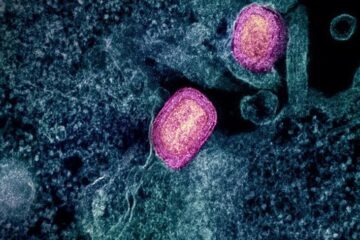TSRI Laboratories Perform Crucial Research in Development of Promising Ebola Virus Treatment

Photo courtesy of The Scripps Research Institute. Scripps Research Institute Professor Erica Ollmann Saphire heads a consortium to find the best antibody cocktail to treat deadly Ebola virus infections.
The conditions of two Americans have reportedly improved since they received a highly experimental antibody cocktail called ZMapp, supplied by San Diego-based Mapp Biopharmaceutical.
The TSRI laboratories of Professor Erica Ollmann Saphire and Assistant Professor Andrew Ward are studying the structures of these antibodies using techniques called electron microscopy, which creates high-resolution images by hitting samples with electrons, and X-ray crystallography, which determines the atomic structure of crystalline arrays of proteins.
Through these images, the team will discover exactly how the immune system molecules bind to the Ebola virus and stop it from functioning, a critical step in drug development.
Ebola virus causes an extremely virulent disease that currently leads to death in 25 to 90 percent of cases. The fast-moving virus is spread via the blood or other bodily fluids of an infected person,
“What we’re showing are sites of vulnerability on the surface of the virus,” said C. Daniel Murin, a graduate student in the Saphire and Ward labs. “These are the chinks in the armor of the virus and the places were you would want your anti-serum to target.”
The ZMapp treatment is still in experimental stages and has not yet been approved for use outside the two recent cases. According to Saphire, ZMapp is one of the best antibody cocktails currently known, but there may still be ways to improve it. She is currently leading a $28 million National Institutes of Health-funded consortium to test antibody cocktails from laboratories around the world, with the goal of finding the best for neutralizing Ebola virus and the many other viruses like it.
An ideal antibody cocktail would ease symptoms and improve the prognosis of infected individuals—it could even work as a preventative measure, protecting healthcare workers before they enter an infected area.
The work on the Ebola virus is part of a larger Vaccine and Global Health Initiative at TSRI, which includes research on HIV/AIDS, influenza and tuberculosis.
More:
1. Outsmarting Viruses: A Profile of Erica Ollmann Saphire
http://www.scripps.edu/newsandviews/e_20140512/ollmann-saphire.html
2. Video: Creating a Roadmap for New Treatments
https://www.youtube.com/watch?v=eEtu-TPPR2A&list=UUYZkc-c8pRYOb-45g52Gegg
3. Consortium Wins Up to $28 Million to Find Best Ebola Treatment
http://www.scripps.edu/newsandviews/e_20140324/ollmann_saphire.html
4. TSRI’s Vaccine and Global Health Initiative
http://www.scripps.edu/philanthropy/pdfs/vaccines.pdf
About the Scripps Research Institute
The Scripps Research Institute (TSRI) is one of the world's largest independent, not-for-profit organizations focusing on research in the biomedical sciences. TSRI is internationally recognized for its contributions to science and health, including its role in laying the foundation for new treatments for cancer, rheumatoid arthritis, hemophilia, and other diseases. An institution that evolved from the Scripps Metabolic Clinic founded by philanthropist Ellen Browning Scripps in 1924, the institute now employs about 3,000 people on its campuses in La Jolla, CA, and Jupiter, FL, where its renowned scientists—including three Nobel laureates—work toward their next discoveries. The institute's graduate program, which awards PhD degrees in biology and chemistry, ranks among the top ten of its kind in the nation. For more information, see www.scripps.edu.
Contact Information
Mika Ono
mikaono@scripps.edu
858-784-2052
Media Contact
All latest news from the category: Life Sciences and Chemistry
Articles and reports from the Life Sciences and chemistry area deal with applied and basic research into modern biology, chemistry and human medicine.
Valuable information can be found on a range of life sciences fields including bacteriology, biochemistry, bionics, bioinformatics, biophysics, biotechnology, genetics, geobotany, human biology, marine biology, microbiology, molecular biology, cellular biology, zoology, bioinorganic chemistry, microchemistry and environmental chemistry.
Newest articles

After 25 years, researchers uncover genetic cause of rare neurological disease
Some families call it a trial of faith. Others just call it a curse. The progressive neurological disease known as spinocerebellar ataxia 4 (SCA4) is a rare condition, but its…

Lower dose of mpox vaccine is safe
… and generates six-week antibody response equivalent to standard regimen. Study highlights need for defined markers of mpox immunity to inform public health use. A dose-sparing intradermal mpox vaccination regimen…

Efficient, sustainable and cost-effective hybrid energy storage system for modern power grids
EU project HyFlow: Over three years of research, the consortium of the EU project HyFlow has successfully developed a highly efficient, sustainable, and cost-effective hybrid energy storage system (HESS) that…





















